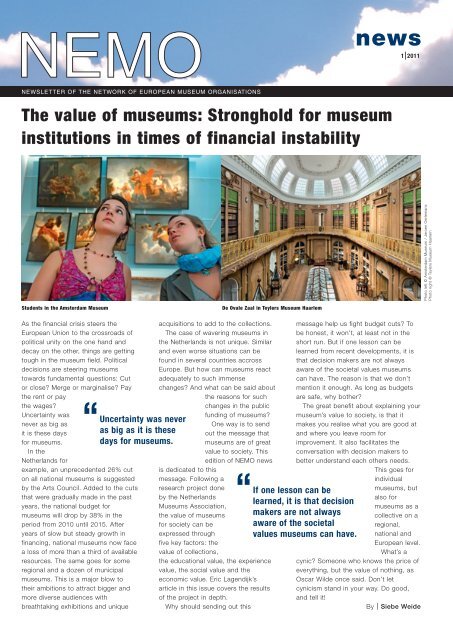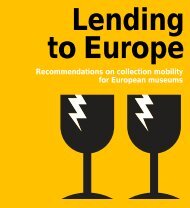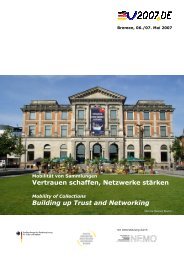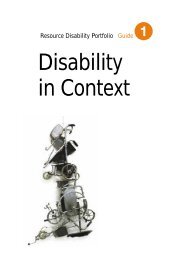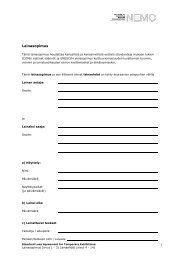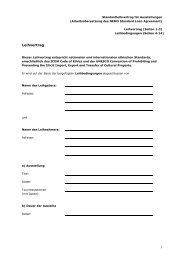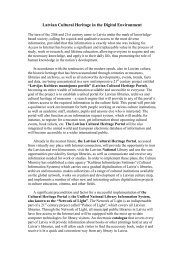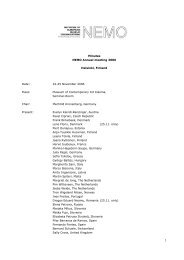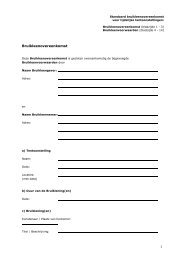The value of museums - Network of European Museum Organisations
The value of museums - Network of European Museum Organisations
The value of museums - Network of European Museum Organisations
Create successful ePaper yourself
Turn your PDF publications into a flip-book with our unique Google optimized e-Paper software.
news<br />
1 | 2011<br />
Newsletter <strong>of</strong> the <strong>Network</strong> <strong>of</strong> <strong>European</strong> <strong>Museum</strong> <strong>Organisations</strong><br />
<strong>The</strong> <strong>value</strong> <strong>of</strong> <strong>museums</strong>: Stronghold for museum<br />
institutions in times <strong>of</strong> financial instability<br />
Photo left © Amsterdam <strong>Museum</strong> / Jeroen Oerlemans<br />
Photo right © Teylers <strong>Museum</strong> Haarlem<br />
Students in the Amsterdam <strong>Museum</strong><br />
De Ovale Zaal in Teylers <strong>Museum</strong> Haarlem<br />
As the financial crisis steers the<br />
<strong>European</strong> Union to the crossroads <strong>of</strong><br />
political unity on the one hand and<br />
decay on the other, things are getting<br />
tough in the museum field. Political<br />
decisions are steering <strong>museums</strong><br />
towards fundamental questions: Cut<br />
or close Merge or marginalise Pay<br />
the rent or pay<br />
the wages<br />
“<br />
Uncertainty was<br />
never as big as<br />
it is these days<br />
for <strong>museums</strong>.<br />
In the<br />
Netherlands for<br />
example, an unprecedented 26% cut<br />
on all national <strong>museums</strong> is suggested<br />
by the Arts Council. Added to the cuts<br />
that were gradually made in the past<br />
years, the national budget for<br />
<strong>museums</strong> will drop by 38% in the<br />
period from 2010 until 2015. After<br />
years <strong>of</strong> slow but steady growth in<br />
financing, national <strong>museums</strong> now face<br />
a loss <strong>of</strong> more than a third <strong>of</strong> available<br />
resources. <strong>The</strong> same goes for some<br />
regional and a dozen <strong>of</strong> municipal<br />
<strong>museums</strong>. This is a major blow to<br />
their ambitions to attract bigger and<br />
more diverse audiences with<br />
breathtaking exhibitions and unique<br />
Uncertainty was never<br />
as big as it is these<br />
days for <strong>museums</strong>.<br />
acquisitions to add to the collections.<br />
<strong>The</strong> case <strong>of</strong> wavering <strong>museums</strong> in<br />
the Netherlands is not unique. Similar<br />
and even worse situations can be<br />
found in several countries accross<br />
Europe. But how can <strong>museums</strong> react<br />
adequately to such immense<br />
changes And what can be said about<br />
the reasons for such<br />
changes in the public<br />
funding <strong>of</strong> <strong>museums</strong><br />
One way is to send<br />
out the message that<br />
<strong>museums</strong> are <strong>of</strong> great<br />
<strong>value</strong> to society. This<br />
edition <strong>of</strong> NEMO news<br />
is dedicated to this<br />
message. Following a<br />
“<br />
research project done<br />
by the Netherlands<br />
<strong>Museum</strong>s Association,<br />
the <strong>value</strong> <strong>of</strong> <strong>museums</strong><br />
for society can be<br />
expressed through<br />
five key factors: the<br />
<strong>value</strong> <strong>of</strong> collections,<br />
the educational <strong>value</strong>, the experience<br />
<strong>value</strong>, the social <strong>value</strong> and the<br />
economic <strong>value</strong>. Eric Lagendijk’s<br />
article in this issue covers the results<br />
<strong>of</strong> the project in depth.<br />
Why should sending out this<br />
message help us fight budget cuts To<br />
be honest, it won’t, at least not in the<br />
short run. But if one lesson can be<br />
learned from recent developments, it is<br />
that decision makers are not always<br />
aware <strong>of</strong> the societal <strong>value</strong>s <strong>museums</strong><br />
can have. <strong>The</strong> reason is that we don’t<br />
mention it enough. As long as budgets<br />
are safe, why bother<br />
<strong>The</strong> great benefit about explaining your<br />
museum’s <strong>value</strong> to society, is that it<br />
makes you realise what you are good at<br />
and where you leave room for<br />
improvement. It also facilitates the<br />
conversation with decision makers to<br />
better understand each others needs.<br />
This goes for<br />
individual<br />
If one lesson can be<br />
learned, it is that decision<br />
makers are not always<br />
aware <strong>of</strong> the societal<br />
<strong>value</strong>s <strong>museums</strong> can have.<br />
<strong>museums</strong>, but<br />
also for<br />
<strong>museums</strong> as a<br />
collective on a<br />
regional,<br />
national and<br />
<strong>European</strong> level.<br />
What’s a<br />
cynic Someone who knows the price <strong>of</strong><br />
everything, but the <strong>value</strong> <strong>of</strong> nothing, as<br />
Oscar Wilde once said. Don’t let<br />
cynicism stand in your way. Do good,<br />
and tell it!<br />
By | Siebe Weide
2<br />
news<br />
1 | 2011<br />
EU News<br />
A Letter from the NEMO<br />
Chairman<br />
NEMO Activities<br />
Value <strong>of</strong> <strong>Museum</strong>s<br />
An Interview with<br />
Vladimír Šucha<br />
ABOUT: Hungary<br />
Page 2<br />
Page 3<br />
Page 4<br />
Page 6<br />
Page 8<br />
NEMO – <strong>The</strong> <strong>Network</strong> <strong>of</strong> <strong>European</strong><br />
<strong>Museum</strong> <strong>Organisations</strong> is an independent<br />
network representing the <strong>European</strong> museum<br />
community. For more information about<br />
NEMO, visit: www.ne-mo.org<br />
news<br />
is produced by the<br />
German <strong>Museum</strong>s Association<br />
Editor: Johannes Schmitt-Tegge<br />
Co-editor: Marie-Louise Chagnaud<br />
Picture Research: Johannes Schmitt-Tegge<br />
Contributors: Marie-Louise Chagnaud,<br />
Gábor Ébli, Erik Langendijk, Johannes<br />
Schmitt-Tegge, Siebe Weide<br />
Design: Hannu Rinne<br />
Printing: MK Druck, Berlin, Germany<br />
NEMO News is also available in pdf format at<br />
www.ne-mo.org<br />
Looking for MUSEUMpartners<br />
in EU-projects<br />
Go to our website:<br />
www.ne-mo.org<br />
With the support <strong>of</strong> the <strong>European</strong><br />
Community budget line ‘Support for<br />
bodies active at <strong>European</strong> level in the<br />
field <strong>of</strong> culture’<br />
“This project has been funded with<br />
support from the <strong>European</strong> Commission.<br />
This publication reflects the views only <strong>of</strong><br />
the author, and the Commission<br />
cannot be held responsible for any use<br />
which may be made <strong>of</strong> the information<br />
contained therein.”<br />
Online consultation on Europe’s<br />
new culture policy<br />
NEMO’s contribution the the Culture Programme 2014-2020<br />
A budget no smaller than 400 Million Euros has funded cultural projects and initiatives<br />
since the EU started its culture programme in 2007. So far, the budget has helped to<br />
enhance Europe’s cultural heritage by developing cross-border cooperation between<br />
cultural operators and institutions. Due to its success, the <strong>European</strong> Parliament and<br />
Council are working on a new culture programme, which is to replace the current one in<br />
2013. In order to continue its funding, the EU has launched a public consultation to<br />
collect views from different sides. <strong>The</strong> Commission is gathering views from citizens,<br />
public and private organisations, local and regional authorities, ministries, relevant<br />
stakeholders in the field <strong>of</strong> culture in the EU and in third countries. Views are sought<br />
regarding the objectives, activities, and types <strong>of</strong> support within the new programme.<br />
NEMO has taken this opportunity to express its opinion on the challenges facing<br />
Europe’s cultural sector. In the stakeholder consultation, NEMO has not only expressed<br />
that there is a continuing need for a culture programme, but that the EU’s main task<br />
remains forming one <strong>European</strong> common market for all goods, including the cultural ones.<br />
In NEMO’s opinion, legal and procedural barriers between countries are artificial<br />
obstacles that can and must to be broken down in order to improve the transnational<br />
flow <strong>of</strong> cultural works and products. Regarding the unhindered mobility <strong>of</strong> works, the<br />
<strong>value</strong> <strong>of</strong> cooperation and reciprocity, the need to reduce the costs <strong>of</strong> lending and<br />
borrowing and the need to explore new modalities <strong>of</strong> mobility, NEMO stated: “This<br />
objective tackles the heart and main task <strong>of</strong> the EU.” For <strong>museums</strong>, the mobility <strong>of</strong><br />
collections, exhibitions and museum pr<strong>of</strong>essionals are key to furthering, dispersing and<br />
developing their activities. To enhance mobility additionally, suitable working programmes<br />
with third countries beyond EU borders and around the world should also be<br />
encouraged.<br />
“<br />
Mobility tackles the heart and main task <strong>of</strong> the EU.<br />
Another main objective <strong>of</strong> the new programme should be the physical and digital<br />
access to <strong>museums</strong>. “An active, vital, thriving cultural sector contributes to the<br />
development <strong>of</strong> society as a whole”, stated NEMO, and requested legal and policy action<br />
to make <strong>museums</strong> accessible to all citizens. <strong>The</strong> network’s representatives see digital<br />
distribution and exhibition platforms as one <strong>of</strong> the objectives at the top <strong>of</strong> the list, but<br />
also pointed out that digitisation should not be overrated. “It is clearly the only option in<br />
many cases but, for many <strong>museums</strong>, the use <strong>of</strong> the internet is more about attracting<br />
audiences to experience the real objects than providing digital access to collections”,<br />
stated NEMO.<br />
Regarding access, NEMO noted: “Too much culture is produced by, aimed at and<br />
consumed by ‘middle class citizens’”. <strong>The</strong>refore <strong>European</strong> Programmes should also<br />
engage people who are economically and educationally disadvantaged. One central<br />
aspect that the new culture programme had not proposed, is the educational <strong>value</strong> <strong>of</strong><br />
<strong>museums</strong>. Education being one <strong>of</strong> the goals <strong>of</strong> the new “Europe 2020” strategy, NEMO<br />
sees it as vital to promote this issue and to fund it additionally.<br />
<strong>The</strong> transnational exchange <strong>of</strong> artefacts and international networking for exchanging<br />
experience and practice were other subjects <strong>of</strong> great relevance and importance in the<br />
representatives’ points <strong>of</strong> view. Furthermore, NEMO suggested to increase the funding <strong>of</strong><br />
informal and formal non-governmental networks who are usually run by volunteers and<br />
have little or no staffing, since they improve the collective view in place <strong>of</strong> institutional<br />
interests. Multi-annual funding was another suggestion, since the short-term perspective<br />
<strong>of</strong> one year can quickly hinder projects to be sustainable and successful and prevents<br />
organisations from developing a long-term strategy for their work.<br />
By | Johannes Schmitt-Tegge<br />
You can download NEMO’s contribution to the consultation <strong>of</strong> cultural stakeholders at www.ne-mo.org ><br />
Activities & News > News & Statements > Archive 2010.
1 | 2011<br />
A Letter from the<br />
NEMO Chairman<br />
news<br />
3<br />
Making plans in Europe takes a lot <strong>of</strong><br />
time and patience. While the programme<br />
Culture 2007 is still running, the<br />
preparation <strong>of</strong> Culture 2014 is already a<br />
year underway. Under this programme<br />
the Union is defining its activities within<br />
the field <strong>of</strong> <strong>museums</strong> and has set itself<br />
several goals. It aims for mobility <strong>of</strong><br />
pr<strong>of</strong>essionals, collections and works <strong>of</strong><br />
art, and encourages the intercultural<br />
dialogue between <strong>European</strong>s. <strong>The</strong><br />
strategic background is even more<br />
ambitious. Culture is seen as the catalyst<br />
for creativity, which is needed to fulfill the<br />
Europe 2020 Strategy and make Europe<br />
the most innovative economy in the world.<br />
Although the Lisbon Agenda is<br />
replaced by a new growth strategy due<br />
to the lack <strong>of</strong> results, its aims are still at<br />
hand. <strong>The</strong>refore, in the consultation on<br />
the new Culture programme, NEMO will<br />
prompt the issue <strong>of</strong> innovation within<br />
<strong>museums</strong> as a condition to generate<br />
NEMO Activities<br />
NEMO’s new website<br />
added <strong>value</strong> to the Europe 2020<br />
Strategy. <strong>Museum</strong>s are at the brink <strong>of</strong><br />
huge innovations in their field <strong>of</strong> work.<br />
<strong>The</strong> real step into the digital society is to<br />
be made, but experiments are still<br />
necessary in order to find the right way<br />
for adding to <strong>museums</strong>’ <strong>value</strong>s by<br />
means <strong>of</strong> the world wide web. Solutions<br />
for financing <strong>museums</strong> are still in<br />
development, such as crowdfunding and<br />
new forms <strong>of</strong> patronage. Simultaneously,<br />
<strong>museums</strong> are experiencing new<br />
opportunities in life long learning,<br />
tourism and other aspects.<br />
We hope that Europe can fund or<br />
co-fund these necessary innovations, for<br />
the funding <strong>of</strong> <strong>museums</strong> as such is<br />
under big pressure. In return, <strong>museums</strong><br />
should open themselves to even more<br />
cooperation on a <strong>European</strong> level, to<br />
which NEMO is committed and serves<br />
as the platform.<br />
By | Siebe Weide<br />
Photo © Fred Ernst<br />
2011 started with the launch <strong>of</strong> a new layout for NEMO’s website.<br />
We have worked towards a clear structure, reflecting the wide<br />
content and information available on the website. This includes<br />
in-depth information about the structure and history <strong>of</strong> the network<br />
itself, a member map with contact details, a section on news,<br />
projects and activities as well as major topics relevant to the<br />
museum community. Another section provides links to museum<br />
associations and ministries <strong>of</strong> culture across Europe along with notes<br />
for further reading on cultural politics. <strong>The</strong> new RSS feed allows you<br />
to stay up to date with the latest news, publications and events<br />
regarding our network.<br />
You can visit the NEMO website at www.ne-mo.org<br />
Framework-Partnership between NEMO and the EACEA<br />
NEMO has been granted a three years operating budget from the Education Audiovisual<br />
and Culture Executive Agency (EACEA) <strong>of</strong> the <strong>European</strong> Commission (EC). This financial<br />
support over three years can be considered as a recognition <strong>of</strong> NEMO’s work up to this<br />
day. <strong>The</strong> network has also been given a good opportunity to develop its work further.<br />
NEMO will aim towards the consolidation <strong>of</strong> its networking activities for <strong>museums</strong> and museum workers in Europe. This<br />
includes providing information to <strong>museums</strong> on relevant EU initiatives and other issues <strong>of</strong> importance to the museum field as<br />
well as lobbying <strong>European</strong> institutions, particularly the EC. NEMO responds to policy issues such as copyright, funding<br />
programmes, statistics, and the role <strong>of</strong> <strong>museums</strong>. It will continue to increase the communication and evaluate the structure<br />
and activities <strong>of</strong> the network.
4<br />
news<br />
1 | 2011<br />
<strong>The</strong> social <strong>value</strong> <strong>of</strong> <strong>museums</strong>: more<br />
than beautiful collections alone<br />
Society provides many opportunities for <strong>museums</strong>, as two recent publications from the Netherlands have<br />
shown. <strong>The</strong> five social <strong>value</strong>s <strong>of</strong> <strong>museums</strong> cannot be expressed in figures and monetary <strong>value</strong>. But if<br />
<strong>museums</strong> reach out to governments, civil organisations, educational institutions, cultural funds, the media<br />
and the private sector, they can seize these social <strong>value</strong>s together and turn them into pr<strong>of</strong>it.<br />
Social cost-benefit analyses are<br />
becoming increasingly common as a tool<br />
<strong>of</strong> government, and indeed the question<br />
<strong>of</strong> what resources and services provide<br />
the most <strong>value</strong> and whether this can be<br />
achieved at a lower cost is only logical in<br />
these times <strong>of</strong> austerity. However, not<br />
everything can be expressed in figures<br />
and monetary <strong>value</strong>, a realisation that<br />
prompted the Netherlands <strong>Museum</strong>s<br />
Association to investigate the social<br />
<strong>value</strong> <strong>of</strong> <strong>museums</strong>. In addition, the<br />
Association also commissioned a study<br />
designed to calculate the social <strong>value</strong> <strong>of</strong><br />
<strong>museums</strong> in euros – known as the<br />
welfare effects <strong>of</strong> <strong>museums</strong>.<br />
<strong>Museum</strong>s are a public resource, owing<br />
their existence to private initiative and<br />
public funds. In recent years, they have<br />
also established closer ties with the<br />
market. As the stewards <strong>of</strong> our public<br />
heritage, <strong>museums</strong> contribute<br />
significantly to Dutch society, which<br />
justifies their reliance on public funds.<br />
Impelled by the current cutbacks from<br />
government and general social changes,<br />
<strong>museums</strong> are looking to form alliances<br />
with the community, in order to find a<br />
new balance between private initiative,<br />
government and the market.<br />
Dutch <strong>museums</strong> have a tradition to<br />
uphold when it comes to social<br />
significance and funding. For example,<br />
the Teylers <strong>Museum</strong> in Haarlem was<br />
founded by private individuals in 1784,<br />
becoming the first public venue devoted<br />
to science and art where members <strong>of</strong> the<br />
public had the opportunity to acquire<br />
and share knowledge. During the 19th<br />
century the museum’s collections<br />
gradually expanded, which involved the<br />
addition <strong>of</strong> new exhibition rooms.<br />
Governments also recognised the social<br />
<strong>value</strong> <strong>of</strong> <strong>museums</strong> and began to assume<br />
responsibility for collections and their<br />
preservation, the Dutch central<br />
A kids space designed by Olafur Eliasson in the Hamburger Kunsthalle<br />
government being the first to focus on<br />
<strong>museums</strong> in its cultural policies. <strong>The</strong><br />
nationalisation <strong>of</strong> museum property and<br />
its funding is a permanent legacy <strong>of</strong> the<br />
reign <strong>of</strong> King William I.<br />
“<strong>The</strong> total amount in<br />
government grants<br />
provided to <strong>museums</strong> is<br />
nearly equivalent to the<br />
increased prosperity<br />
these <strong>museums</strong> create.<br />
During the first half <strong>of</strong> the 20th century,<br />
the central government set about to<br />
establish a museum policy, necessitated<br />
to some extent by the growing number<br />
<strong>of</strong> private individuals bequeathing<br />
collections to the government. Municipal<br />
and provincial administrations followed<br />
suit, as did the universities. This<br />
relationship between public and private<br />
initiative along with cultural and civic<br />
organisations has helped create a vital<br />
and easily accessible sector with a high<br />
degree <strong>of</strong> public involvement. <strong>The</strong> most<br />
recent <strong>Museum</strong> Weekend held in the<br />
Netherlands, for example, attracted<br />
nearly one million visitors, demonstrating<br />
the social reach <strong>of</strong> <strong>museums</strong> during a<br />
single weekend.<br />
In the recent publication ‘More than<br />
worth it’ (‘Meer dan waard’), the<br />
research and consultancy firm DSPgroep<br />
systematically described five social<br />
<strong>value</strong>s <strong>of</strong> <strong>museums</strong>. <strong>The</strong> collection<br />
<strong>value</strong> represents the ‘core business’ <strong>of</strong><br />
<strong>museums</strong>: collecting, preserving and<br />
exhibiting special objects, collections<br />
and other resources. <strong>The</strong> connecting<br />
<strong>value</strong> epitomises <strong>museums</strong> as a link<br />
between their collections, the public and<br />
other interested parties, as well as their<br />
role in building a bridge between the<br />
past, present and future. No<br />
organisations are better positioned than<br />
<strong>museums</strong> when it comes to explaining<br />
and interpreting the present and future<br />
by means <strong>of</strong> special objects and stories<br />
gathered from the past. <strong>Museum</strong>s also<br />
serve as learning environments – this can<br />
be called their educational <strong>value</strong>. <strong>The</strong><br />
enjoyment and pleasure people gain from<br />
their visit, the <strong>museums</strong>’ aesthetic<br />
t<br />
Photo © Hamburger Kunsthalle / Ellen Coenders
1 | 2011<br />
news<br />
5<br />
<strong>value</strong>, differs from the economic <strong>value</strong>,<br />
which includes factors such as tourist<br />
spending and job creation. This broad<br />
range <strong>of</strong> <strong>value</strong>s demonstrates that<br />
<strong>museums</strong> are more than just buildings<br />
displaying objects and narrating<br />
episodes <strong>of</strong> our culture heritage.<br />
A recently completed social costbenefit<br />
analysis revealed that the net<br />
annual revenue generated by the<br />
museum sector is roughly equal to the<br />
total amount the sector receives in<br />
government funding. In other words, the<br />
total amount in government grants<br />
provided to <strong>museums</strong> is nearly equivalent<br />
to the increased prosperity these<br />
<strong>museums</strong> create. On balance, every euro<br />
the government invests in <strong>museums</strong><br />
generates another euro, in the form <strong>of</strong><br />
tourist spending, improved knowledge,<br />
and tax revenues. This study – ‘Treasure<br />
<strong>of</strong> the city’ (‘De schat van de stad’) –<br />
was conducted by ‘Atlas voor<br />
Gemeenten’, a reference guide for<br />
municipalities that describes and<br />
explains Dutch neighborhoods, cities and<br />
regions regarding economy,<br />
infrastructure, culture and other factors.<br />
Oscar Wilde famously wrote that a<br />
cynic is someone who knows the price<br />
<strong>of</strong> everything and the <strong>value</strong> <strong>of</strong> nothing.<br />
He was right on the mark: not everything<br />
<strong>of</strong> <strong>value</strong> can be expressed in financial<br />
terms, and <strong>museums</strong> demonstrate that<br />
arguably more than any other sector.<br />
After all, who could fail to be impressed<br />
by all the beautiful, unique, exquisite and<br />
fascinating objects that <strong>museums</strong><br />
collect, conserve and exhibit Like<br />
Wilde’s cynic, museum visitors may also<br />
wonder about the monetary <strong>value</strong> <strong>of</strong> a<br />
particular collection or a world-class<br />
work <strong>of</strong> art.<br />
Family entertainment at the Dutch Water <strong>Museum</strong><br />
Photo © Nederlands Watermuseum / Jurjen Poeles<br />
<strong>The</strong> research <strong>of</strong> the Netherlands<br />
<strong>Museum</strong>s Association aims to highlight<br />
the other side <strong>of</strong> <strong>museums</strong>’ <strong>value</strong>s: their<br />
quality as depositories and exhibition<br />
areas for collections which we, as a<br />
society, can be proud <strong>of</strong>. In addition,<br />
<strong>museums</strong> are valuable because they<br />
attract visitors and tourists, many <strong>of</strong><br />
whom want to enjoy these collections<br />
and learn more about them. <strong>Museum</strong>s<br />
connect people in a variety <strong>of</strong> ways –<br />
people who share a common interest<br />
and passion, which is a social <strong>value</strong> in<br />
itself. This <strong>value</strong> is evident every day, in<br />
the sense that visiting a museum –<br />
alone, with friends, family members or a<br />
school class – is also a day out, a day to<br />
travel to the city centre, another city or<br />
village and immerse yourself in a<br />
collection you are eager to explore.<br />
“Not everything <strong>of</strong> <strong>value</strong><br />
can be expressed in<br />
financial terms, and<br />
<strong>museums</strong> demonstrate<br />
that more than any other<br />
sector.<br />
When we use policy terms such as<br />
‘participation’ and ‘education’,<br />
‘entrepreneurship’ and ’involvement’, we<br />
are really talking about a group <strong>of</strong><br />
children from the local primary school<br />
who go to see a Van Gogh painting for<br />
the first time and wonder how the painter<br />
was able to create such a masterpiece<br />
using all those little dots. We are also<br />
thinking <strong>of</strong> senior citizens from a nearby<br />
care home who visit the Nederlands<br />
Openluchtmuseum (Open Air <strong>Museum</strong>) to<br />
re-experience what the Netherlands was<br />
like when they were growing up. Policy<br />
concepts should always be understood<br />
in their social context and in their<br />
outcome for the public.<br />
Identifying and promoting the public<br />
<strong>value</strong> <strong>of</strong> <strong>museums</strong> is only the beginning.<br />
<strong>The</strong> next step calls for the museum<br />
sector, government and private sector to<br />
join forces and invest in these museum<br />
<strong>value</strong>s, in order to capitalise on this<br />
<strong>value</strong> in a modern and innovative way. In<br />
this process, partnership is vital.<br />
If we factor in social <strong>value</strong> which<br />
cannot be expressed in cash, we also<br />
find that <strong>museums</strong> have a significant<br />
<strong>value</strong> as public resources. <strong>The</strong>refore, a<br />
great deal <strong>of</strong> work is yet to be<br />
accomplished by the museum sector and<br />
society: we can use the social <strong>value</strong> <strong>of</strong><br />
<strong>museums</strong> more effectively if <strong>museums</strong><br />
reach out proactively. This includes<br />
building ties with new, less traditional<br />
partners, including social cooperations<br />
such as housing corporations, health and<br />
immigrant organisations. If the museum<br />
sector, governments, civic organisations,<br />
educational institutions, cultural funds,<br />
the media and the private sector<br />
strengthen and improve their partnerships<br />
and their focus, each euro invested is<br />
sure to create even more pr<strong>of</strong>it.<br />
Staircase at Hamburger Kunsthalle<br />
<strong>Museum</strong>s are venturing beyond their<br />
own gates and are forming alliances with<br />
civil organisations that are somehow<br />
linked to the five <strong>value</strong>s named above.<br />
This is important, as <strong>museums</strong>, their<br />
buildings, their collections and their<br />
resources are at the heart <strong>of</strong> the<br />
community. <strong>The</strong> heritage entrusted to<br />
<strong>museums</strong> is not for sale, which is why<br />
we can all be part <strong>of</strong> it. This is how our<br />
heritage connects us from generation to<br />
generation, visit after visit, story after<br />
story. It opens up enormous potential,<br />
from which we all hope to benefit.<br />
By | Eric Lagendijk<br />
Both publications (only available in Dutch<br />
language) can be downloaded at<br />
www.museumvereniging.nl > Projecten &<br />
onderzoek > Onderzoek > Meer dan waard –<br />
Schat van de stadt<br />
Photo © Romanus Fuhrmann-Rickert
6<br />
news<br />
An Interview with<br />
Vladimír Šucha<br />
1 | 2011<br />
Vladimír Šucha is Director for Culture and Media at the Directorate<br />
General for Education and Culture <strong>of</strong> the <strong>European</strong> Commission.<br />
Formerly he was Director <strong>of</strong> the Slovak Research and Development<br />
Agency and also worked as Principal advisor for <strong>European</strong> Affairs to<br />
the Education Minister <strong>of</strong> Slovakia. He has been working at the Slovak<br />
Representation to the EU in Brussels for four years as counselor for<br />
research, education and culture. At the same time he has a long-term<br />
academic background as full pr<strong>of</strong>essor <strong>of</strong> the Comenius University in<br />
Bratislava and as visiting pr<strong>of</strong>essor in many countries.<br />
In your opinion, what are the most<br />
important <strong>value</strong>s <strong>of</strong> <strong>museums</strong><br />
<strong>Museum</strong>s share a complex set <strong>of</strong> <strong>value</strong>s<br />
associated with memory, which question<br />
our present through exposure <strong>of</strong><br />
contemporary thinking and creation, with<br />
diversity and openness, with<br />
transmission and education. <strong>The</strong>y teach<br />
us many things about our history,<br />
including the wonderful diversity found in<br />
various cultures both past and present.<br />
<strong>The</strong>y tell us about the wonders <strong>of</strong> nature,<br />
technology, science and many other<br />
domains. <strong>The</strong>y collect, preserve and<br />
document items that are important to<br />
humanity including everything from the<br />
mundane and common to the rare and<br />
unique. <strong>The</strong>y present collections,<br />
exhibitions and educational activities that<br />
delight and stimulate intellectual<br />
exploration, creativity and intercultural<br />
dialogue.<br />
While the intrinsic <strong>value</strong> <strong>of</strong> <strong>museums</strong> is<br />
apparent to most, their economic impact<br />
is also worth considering. <strong>Museum</strong>s may<br />
attract tourists and contribute to shaping<br />
the image <strong>of</strong> a region or <strong>of</strong> a city.<br />
<strong>Museum</strong>s such as le Louvre in Paris or<br />
the Tate in London attract millions <strong>of</strong><br />
visitors on a yearly basis. Think also<br />
about the role <strong>of</strong> the Guggenheim<br />
<strong>Museum</strong> in the regeneration strategy <strong>of</strong><br />
Bilbao in Spain. <strong>Museum</strong>s can also<br />
develop, sometimes in partnership with<br />
other actors, pr<strong>of</strong>itable businesses as<br />
supplement to their fundamental<br />
Photo © Vladimír Šucha<br />
missions. <strong>The</strong>y therefore also constitute<br />
an asset for economic development at<br />
local and regional level.<br />
In which way does the Agenda for<br />
Culture reflect these <strong>value</strong>s<br />
<strong>The</strong> Agenda aims at bringing together<br />
and mobilising all the actors around<br />
three major objectives: cultural diversity<br />
and intercultural dialogue; culture as a<br />
catalyst for creativity; and culture as a<br />
key component in international relations.<br />
It has also introduced the Open Method<br />
<strong>of</strong> Coordination (OMC) in the field <strong>of</strong><br />
culture. <strong>The</strong> objective <strong>of</strong> this method is<br />
to increase the cooperation between EU<br />
Member States through the collaborative<br />
work <strong>of</strong> experts on topics <strong>of</strong> common<br />
interest where collaboration can clearly<br />
lead to improvements for the cultural<br />
community in Europe.<br />
“<br />
<strong>Museum</strong>s have to establish<br />
their own priorities, which<br />
are not the same in every<br />
museum, and find out the<br />
ways allowing them to<br />
deliver these outcomes.<br />
Just to give you one example on how<br />
the work <strong>of</strong> these experts can relate to<br />
the activities <strong>of</strong> <strong>museums</strong>: One OMC<br />
group worked on the mobility <strong>of</strong><br />
<strong>museums</strong> collections. This group based<br />
its works on earlier reports like “Lending<br />
to Europe”, published in 2005. In June<br />
2010 it issued recommendations to the<br />
Member States, the museum Community<br />
and the <strong>European</strong> Commission in five<br />
main areas: state indemnity schemes;<br />
immunity from seizure; long-term loans;<br />
prevention <strong>of</strong> theft and illicit trafficking;<br />
and mobility <strong>of</strong> museum pr<strong>of</strong>essionals.<br />
This group will now work on ways and<br />
means to simplify the process <strong>of</strong> lending<br />
and borrowing with the view to<br />
producing a toolkit for use by national<br />
administrations on state indemnity<br />
provisions and other relevant issues.<br />
To give you another example, we also<br />
have a group focusing on how public<br />
culture and arts institutions may widen<br />
their audiences. <strong>The</strong> initial focus <strong>of</strong> the<br />
group will be on widening access and<br />
increasing participation especially by<br />
disadvantaged groups. A further more<br />
specific focus will be on how public arts<br />
and cultural institutions may facilitate<br />
exchanges among cultures and between<br />
social groups. Within this process, the<br />
intercultural dimension <strong>of</strong> heritage will be<br />
at the centre <strong>of</strong> reflections. Even though<br />
the focus is not exclusively on <strong>museums</strong>,<br />
it is clear that <strong>museums</strong> will be a central<br />
element <strong>of</strong> the picture.<br />
To which <strong>of</strong> the six priority areas<br />
mentioned in the Work Plan (diversity,<br />
creative industries, skills and<br />
mobility, cultural heritage, external<br />
relations, statistics) do <strong>museums</strong><br />
contribute strongest, and why<br />
<strong>The</strong> priority on cultural heritage includes<br />
a specific focus on the mobility <strong>of</strong><br />
collections which addresses specifically<br />
issues <strong>of</strong> interest for <strong>museums</strong>. However,<br />
since <strong>museums</strong> clearly contribute to<br />
cultural diversity and intercultural<br />
dialogue, to informal learning (and<br />
therefore to the acquisition <strong>of</strong> skills that<br />
t
1 | 2011<br />
news<br />
7<br />
are not presently taught formally in<br />
schools, like creativity and flexible<br />
thought), to regional development,<br />
almost all areas <strong>of</strong> the new Work Plan for<br />
Culture will benefit from the <strong>museums</strong>’<br />
contribution. Just take the regional<br />
dimension. <strong>The</strong>re are many ways<br />
<strong>museums</strong> can contribute to urban<br />
regeneration, territorial cohesion or social<br />
inclusion across <strong>European</strong> regions. <strong>The</strong>re<br />
is a need to better sensitize regional<br />
authorities about the role <strong>of</strong> culture and<br />
cultural institutions in boosting their<br />
socio-economic development and to<br />
make them realize they can use the<br />
money they get from the Structural<br />
Funds to do just that!<br />
How can <strong>museums</strong> increase their<br />
significance in the other, less<br />
essential areas<br />
It is probably best for each museum to<br />
revisit its missions with a view to<br />
maximize its contribution to society.<br />
<strong>Museum</strong>s have to establish their own<br />
priorities, which are not the same in<br />
every museum, and find out the ways<br />
allowing them to deliver these outcomes.<br />
Public-private partnerships have a good<br />
potential in this context. In more general<br />
terms, <strong>museums</strong> should pay attention to<br />
the rationalisation <strong>of</strong> their collections.<br />
“<br />
We need to do more to<br />
explain the public <strong>value</strong> <strong>of</strong><br />
culture and cultural<br />
institutions.<br />
Sometimes these are too large and<br />
therefore less attractive and coherent to<br />
the public. While I am convinced that<br />
<strong>European</strong> <strong>museums</strong> have reached<br />
excellence in the conservation and<br />
research areas, they should invest in<br />
interactivity, in order to provide “handson”<br />
experiences, which are very valuable<br />
from the educational point <strong>of</strong> view. For<br />
those which haven't done it already,<br />
digitisation remains an important topic.<br />
It provides online access to cultural<br />
heritage collections thus broadening their<br />
scope <strong>of</strong> appeal and making their<br />
resources globally accessible and<br />
engaging with different audiences.<br />
As mentioned in the Dutch study ‘More<br />
than worth it’ (‘Meer dan waard’), the<br />
five <strong>value</strong>s <strong>of</strong> <strong>museums</strong> are the<br />
collection, connecting, educational,<br />
aesthetic and economic <strong>value</strong>. How<br />
does the EC take into account “s<strong>of</strong>t”<br />
merits like e.g. the aesthetic and<br />
connecting <strong>value</strong> <strong>of</strong> <strong>museums</strong><br />
As stated before, at <strong>European</strong> level,<br />
there is increasing awareness on the<br />
potential that <strong>museums</strong> have for urban<br />
regeneration, territorial cohesion and<br />
social inclusion. <strong>The</strong> impact <strong>of</strong><br />
investment in culture to local and<br />
regional development, <strong>of</strong>ten translated in<br />
support to <strong>museums</strong>, has been outlined<br />
in a study that we have recently<br />
commissioned. Nevertheless, we do<br />
recognize that there is a need to<br />
reinforce the narrative, and this is where<br />
the OMC work may play an important<br />
role. <strong>The</strong> expected outcome <strong>of</strong> the OMC<br />
will be a handbook outlining good<br />
practices but also principles and<br />
concrete methods for implementation <strong>of</strong><br />
a consistent policy on inclusion and<br />
diversity in cultural institutions; we hope<br />
that this will provide a useful contribution<br />
to the effort that <strong>museums</strong> are<br />
undertaking.<br />
Where do you see need for<br />
improvement in <strong>European</strong> policy<br />
making regarding <strong>museums</strong>’ <strong>value</strong>s<br />
We are open to any recommendation<br />
that suggests improvements in our policy<br />
towards <strong>museums</strong>. It should however not<br />
be forgotten that Member States,<br />
regional and local authorities have a<br />
more important role to play in this<br />
context than the <strong>European</strong> Commission<br />
itself, not only due to the principle <strong>of</strong><br />
subsidiarity, fully applicable in the area,<br />
but also due to the fact that <strong>museums</strong><br />
shall work as poles <strong>of</strong> attraction,<br />
development and learning at the<br />
grassroots level. <strong>The</strong> approach should<br />
be bottom-up, not the other way round.<br />
In times <strong>of</strong> financial crisis and<br />
budget cuts, <strong>museums</strong> as public<br />
institutions have to explain their<br />
social significance and relevance.<br />
How can museum institutions<br />
maintain their role in spite <strong>of</strong><br />
cutbacks in the cultural sector<br />
I agree with you that the final crises did<br />
not create the best atmosphere for the<br />
public financing <strong>of</strong> the cultural sector.<br />
However, the awareness <strong>of</strong> public<br />
authorities must be raised to the fact<br />
that <strong>museums</strong> have <strong>value</strong>,<br />
encompassing, but not confined to,<br />
utilitarian and instrumental outcomes.<br />
As I mentioned before, <strong>museums</strong> attract<br />
tourists and other business interests.<br />
But if political support for <strong>museums</strong><br />
decreases, how can museum<br />
institutions achieve social objectives<br />
while maintaining and safeguarding<br />
their <strong>value</strong>s and identity<br />
This is not an easy question and there is<br />
no easy answer. It is not specific to<br />
<strong>museums</strong> but spreads more broadly<br />
through the entire cultural sector. We<br />
need to do more to explain the public<br />
<strong>value</strong> <strong>of</strong> culture and cultural institutions.<br />
It is necessary not only to maintain some<br />
level <strong>of</strong> public funding but also to attract<br />
new categories <strong>of</strong> donors. At the same<br />
time, the legal framework and fiscal<br />
environment have to facilitate private<br />
investments and donations to cultural<br />
institutions. On the other side, cultural<br />
institutions have to be more open to new<br />
partnerships, to managing and financing<br />
different activities in different ways,<br />
extracting revenue from more business<br />
oriented activities to finance more public<br />
service missions.<br />
Which museum <strong>value</strong>s will face the<br />
greatest challenges in the years to<br />
come, and why<br />
Recent policies tend to over-emphasise<br />
the measurable economic impact <strong>of</strong><br />
services or institutions for the public<br />
good, using market data for that<br />
purpose. <strong>The</strong> challenge for <strong>museums</strong> will<br />
be to provide quantified data to justify<br />
being granted public support and to<br />
prove that the benefits they provide are<br />
not all open to economic evidence.<br />
Pressured into delivering against social<br />
and economic policy objectives and<br />
required to justify their existence in terms<br />
specified by funding bodies, <strong>museums</strong><br />
could develop a typology that describes<br />
their <strong>value</strong> regardless <strong>of</strong> figures and<br />
monetary benefits.<br />
By | Johannes Schmitt-Tegge<br />
You can download the Study on the contribution<br />
<strong>of</strong> culture to local and regional development at<br />
http://ec.europa.eu/culture/key-documents/<br />
doc2942_en.htm
8<br />
news<br />
About: Hungary<br />
In noble rivalry with Vienna and other centres in the region, Budapest<br />
ambitiously developed various <strong>museums</strong> until World War I. However,<br />
economic demise and, mostly after World War II, political isolation<br />
prevented the country from completing this programme. Now, more<br />
than two decades past the end <strong>of</strong> Communism, how have democracy<br />
and market economy shaped the museum scene<br />
1 | 2011<br />
Photo © Magyar Nemzeti Múzeum<br />
Whilst the greatest asset <strong>of</strong> Hungary’s<br />
<strong>museums</strong> still lies in their collections built<br />
up in their Golden Age peaking in the<br />
1910s, these holdings have remained<br />
incomplete in range and uneven in<br />
quality. Especially the international<br />
sections have failed to grow, turning<br />
Hungarian <strong>museums</strong> increasingly into<br />
national institutions over the past<br />
hundred years. Another setback is the<br />
lack <strong>of</strong> new museum buildings<br />
throughout the 20th century. Vast<br />
collections (such as a long-planned<br />
Science <strong>Museum</strong>) have never yet had<br />
appropriate placement, resting in depots.<br />
<strong>The</strong> Hungarian National <strong>Museum</strong> in Budapest<br />
<strong>The</strong> presentation <strong>of</strong> the collections<br />
also calls for new strategies. Although<br />
visitors expect dynamism, many<br />
<strong>museums</strong> focus still on the permanent<br />
exhibition, indeed its rather conservative<br />
version. Hungarian institutions only<br />
slowly depart from the authoritative<br />
status <strong>of</strong> holders <strong>of</strong> objective truth. A<br />
good example to follow includes the<br />
Skanzen Open-air <strong>Museum</strong> in<br />
Szentendre.<br />
Few museologists dare to address<br />
sensitive topics. A number <strong>of</strong> colleagues<br />
consider their workplace still an ivory<br />
tower, exhibitions tend to evade<br />
controversies. Positive cases include the<br />
thought-provoking shows <strong>of</strong> the<br />
Holocaust <strong>Museum</strong>, the Gizi Bajor<br />
<strong>Museum</strong> <strong>of</strong> <strong>The</strong>atre and the Municipal<br />
Art <strong>Museum</strong> in Miskolc. It is one <strong>of</strong> the<br />
greatest challenges to make more<br />
<strong>museums</strong> venture into the domain <strong>of</strong><br />
critical discourse and adopt new<br />
methods <strong>of</strong> presentation.<br />
Whereas many museum curators<br />
expect the central and local governments<br />
to bolster the crumbling budgets <strong>of</strong> the<br />
institutions first as a condition <strong>of</strong><br />
improved performance, others argue that<br />
politicians are unlikely to fund <strong>museums</strong><br />
more generously as long as these cater<br />
but to a narrow audience, providing only<br />
limited public benefit. <strong>The</strong> Communist<br />
regime (1948-1988) supplied <strong>museums</strong>,<br />
like all fields <strong>of</strong> culture, with more<br />
financial means; yet this safe background<br />
reduced their ability to produce and<br />
present research according to public<br />
interest.<br />
Since the fall <strong>of</strong> the Berlin Wall,<br />
<strong>museums</strong> outside the capital have<br />
suffered the biggest losses. In the cities<br />
and provinces all <strong>museums</strong> are under the<br />
waning patronage <strong>of</strong> local authorities;<br />
and many (e.g. in Székesfehérvár and<br />
Szombathely) had, no doubt, a more<br />
flourishing period three to four decades<br />
ago than now. Pécs boosted its<br />
<strong>museums</strong> briefly as <strong>European</strong> Capital <strong>of</strong><br />
Culture in 2010; Debrecen has recently<br />
erected a new exhibition centre with the<br />
overt aim <strong>of</strong> competing with the capital;<br />
Győr, Paks and Vác have all succeeded<br />
in expanding their <strong>museums</strong> over the<br />
past 20 years.<br />
Some <strong>museums</strong> cooperate with private<br />
benefactors, mostly in art. <strong>The</strong> first<br />
private art museum in Budapest (MEO)<br />
closed after a few years, another one in<br />
Kogart is being managed on a<br />
sustainable basis, yet in prolonged<br />
conflict with the arts pr<strong>of</strong>ession over<br />
matters <strong>of</strong> ethics and content. In<br />
Veszprém, the municipality and private<br />
collector László Vass collaborate<br />
excellently, suggesting that civil society<br />
should be given a bigger stake in setting<br />
up and running <strong>museums</strong>; only too many<br />
in the pr<strong>of</strong>ession cling to the paternalist<br />
concept <strong>of</strong> the state looking after culture.<br />
Construction boom after the Millennium<br />
yielded growth in archaeology, with the<br />
administrative side <strong>of</strong> heritage preservation<br />
remaining a political battlefield to date.<br />
Bad luck for these institutions Not<br />
necessarily. Many other <strong>museums</strong> in the<br />
country yearn for similar attention by<br />
politicians and the media, if with less<br />
conflict. <strong>The</strong> museum landscape is still<br />
one <strong>of</strong> Hungary’s Sleeping Beauties, to be<br />
re-invigorated by better university training,<br />
wider on-line access, clever cultural<br />
tourism, bold urban development, and a<br />
generation change among the opinionmakers,<br />
as much as to be re-discovered<br />
by the international community.<br />
Hungary<br />
By | Gábor Ébli<br />
is situated in the Pannonian<br />
Basin in Central Europe. Since<br />
its total revision in 1989, the<br />
constitution safeguards<br />
Hungary as a parlamentary<br />
democratic republic. Counting<br />
10 million inhabitants, the<br />
country has become one <strong>of</strong><br />
the top 30 tourist destinations<br />
worldwide, making tourism<br />
one <strong>of</strong> the most important<br />
sources <strong>of</strong> income. Especially<br />
the country’s capital and<br />
largest city Budapest is well<br />
visited.


